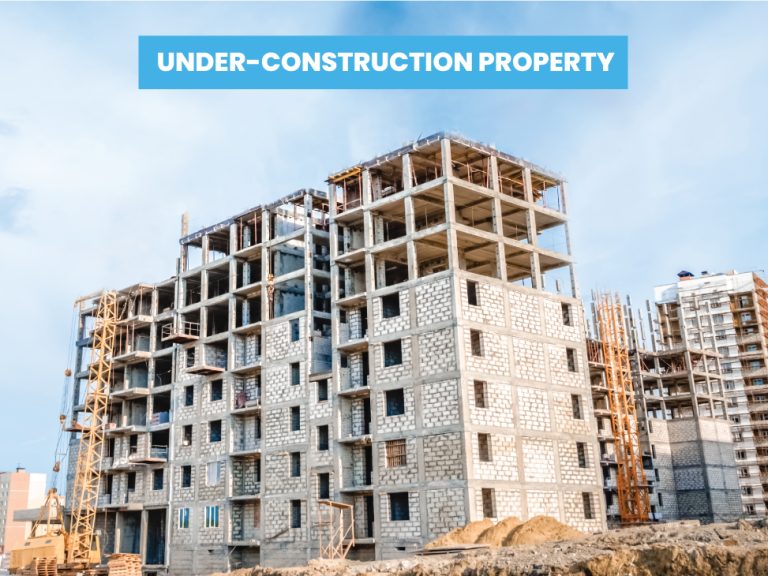Last Updated on 17th October 2024
Getting home loan is very BASIC now
Get a loan in under 5 mins

Last Updated on 17th October 2024
Being a first-time homeowner can both be exhilarating and intimidating, especially when the property is still under construction. Taking the time to understand what goes into a home loan for under-construction property is crucial. Home loans for under-construction properties come with specific requirements and conditions. It is important to be aware of these requirements to make an informed decision. Additionally, it is important to shop around and compare different lenders to get the best deal. This blog aims to unravel the complexities of such loans, ensuring you are well-equipped to make informed decisions on your path to owning your dream home.
Table of Contents
At the outset, it’s essential to comprehend what a home loan for under-construction property entails. Unlike standard home loans issued for ready-to-move-in properties, these loans are specifically tailored for properties still under construction. They stand out due to their unique disbursement process, where the loan amount is released in stages, aligned with the construction progress. This phased disbursement impacts the EMI (Equated Monthly Installment) calculations and payments, making it a critical factor for potential borrowers to consider.
The home loan disbursement process for under-construction properties is a systematic one. The disbursed amount is often aligned with the construction stages of the property. As the construction progresses, the builder requests funds, which, upon verification by the lender, are released. This process ensures that the loan amount is utilized efficiently and in sync with the construction timeline. It’s a safeguard mechanism that protects the interests of both the borrower and the lender.
Suggested read: Difference Between a Construction Loan and Home Loan
Suggested read: Home Construction Loans in India
Under-construction home loans require a strategic approach. When dealing with builders, negotiation is key. The ability to negotiate the property price can significantly impact the total loan amount and, subsequently, the interest payments.
Suggested read: Documents Required for Home Construction Loan
The financial implications of an under-construction home loan extend beyond just interest and principal repayments. Tax benefits are a significant aspect, with borrowers being able to claim deductions on the interest paid during the construction period under Section 80C of the Income Tax Act. However, it’s important to note that these benefits kick in only once the construction is completed, and the deductions on the interest paid during the construction period can be claimed in five equal installments.
Consider the example of Mr. Sharma, who opts for an under-construction home loan to build his dream home. He negotiates the property price with the builder, reducing the overall loan requirement. As construction progresses, the loan is disbursed in stages, with Mr. Sharma paying pre-EMI interest on the disbursed amount. Upon completion, the loan transitions into a standard mortgage, with Mr. Sharma now paying regular EMIs. He also benefits from tax deductions post-completion, easing his financial burden.
Yes, you can obtain a loan for an under-construction property. These loans are designed specifically for properties that are in the process of being built. The loan disbursement in such cases is usually linked to the construction stages of the property.
You can claim tax benefits on a home loan for an under-construction property. However, you can claim these benefits only after the construction is completed. The interest paid during the construction period can be claimed as a deduction in five equal installments starting from the year in which construction is completed.
Yes, you can opt to start paying full EMIs on an under-construction property. This decision depends on your financial situation and the terms offered by your lender. Some borrowers choose to pay only the interest (pre-EMI) on the disbursed loan amount until the construction is completed, while others may start paying full EMIs immediately.
The downpayment for an under-construction property typically ranges between 10% to 30% of the property’s value, depending on the lender’s policy and your loan eligibility. It’s important to clarify this with your lender as it can vary.
The pre-construction period for a housing loan refers to the period from the date of borrowing the loan until the construction of the property starts or the end of the financial year immediately preceding the year in which the construction commences, whichever is earlier. Interest paid during this period can be claimed as a tax deduction in five equal annual installments, starting from the year in which the construction is completed.
Buying an under-construction property can be advantageous due to potentially lower prices compared to ready-to-move-in properties, and the ability to customize or choose preferred units. However, it also comes with risks like construction delays. It’s important to assess the builder’s credibility, the project’s legal clearances, and your financial stability before making a decision.
The amount of loan you can get for construction depends on various factors including your income, repayment capacity, the property’s value, and the lender’s policies. Typically, lenders finance up to 75% to 90% of the construction cost. It’s best to consult with lenders to get an accurate idea based on your specific circumstances.